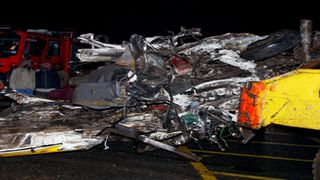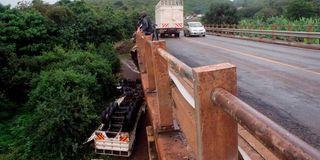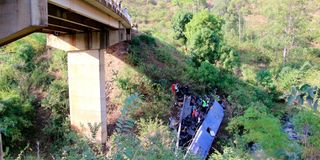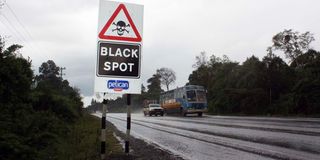
One of the wreckages is towed away from the accident scene at Londiani Junction along the Nakuru-Kericho Highway on June 30, 2023
| John Njoroge | Nation Media GroupWeekly Review
Premium
Nairobi-Meru, Kisumu-Muhoroni among Kenya's top killer highways
The brakes of a heavy vehicle – petrol tanker, truck or public transport bus – fail on a steep slope before ramming into people by the roadside or plunging into a river at a bend of the road, leaving in its trail death and tears.
This is the script that has over the last five decades characterised accidents on Kenya’s highways, claiming multiple lives in a single smash.
On June 30, it happened again – at Londiani in Kericho County, along the Nakuru-Kisumu highway, after a truck carrying a shipping container veered out of control and ploughed into multiple other vehicles and people – mostly traders – leaving 52 dead.
The accident, so far the deadliest this year, attracted huge attention locally and internationally, courtesy of its impact, massive loss of life and widespread media coverage.
President William Ruto led Kenyans in mourning the departed as world leaders, including the African Union Commission boss, Moussa Faki Mahamat, sent condolences to affected families.
Killer roads in Kenya, including the Kisumu-Muhoroni highway, Nairobi-Meru highway and Sagana-Karatina road in Kirinyaga County, have over the decades claimed hundreds of lives and caused families untold suffering.
Only six days before the Londiani crash, five pupils from Ebenezer Academy in Busia County died under almost similar circumstances, when their school bus was hit from behind by a truck after its brakes failed on a slope at Kaburengu in Kakamega County. In July 2020, 10 traders were run over by a lorry at the Kaburengu junction, again after its brakes failed.
Like many black spots marked along highways across the country, the Kaburengu stretch, near Webuye town, is on steep and slippery terrain.
It has a sharp bend that dips towards a bridge over River Sasala. Many speeding motorists end up plunging into the river. The situation is further complicated by the high traffic of sugarcane tractors in this western Kenya sugar belt region.
Back in Kericho County, a bus crash five years ago, in October 2018, claimed the lives of 52 people – the same as in the Londiani accident – after a bus that was going downhill hit a guardrail and plunged into the valley at Fort Ternan. This stretch the road has many steep slopes and bends.
The Sagana Bridge along the Sagana-Karatina road in Kirinyaga County, which has similar terrain, has been a death trap for road users for decades. Here, drivers struggle going downhill at the marked black spot. Most accidents happen when brakes fail, often causing the vehicles to plunge into the river.
But it is the steep, two-kilometre slope that ends at the Nithi River in Tharaka-Nithi County that has claimed the largest number of lives of road users.
It is here, in 2000, that the deadliest recorded road tragedy in Kenya’s history occurred when 158 passengers travelling in a Tawfiq bus from Maua to Mombasa perished when it plunged into the river after the driver lost control of it.

Scene of an accident involving a trailer along the Nyeri-Nairobi highway at Sagana Bridge on December 19, 2017.
Alive to the fact that a host of these accidents are as a result of poor road engineering work – at the planning and design stages as well as workmanship thereafter – Transport Cabinet Secretary, Kipchumba Murkomen says his ministry is planning to introduce digital records to help monitor contractors on the road, and offenders as well. The ministry also hopes to increase inspection centres across the country from the current 30 to ensure quality service.
“In the long run, we hope that our highways will have speed cameras and those that can collect other information related to traffic offenses,” says the CS.

The wreckage of a bus that plunged into the Nithi River bridge along the Meru-Nairobi highway, killing 34 people in 2022.
In an effort to curb increased road carnage and streamline the chaotic public transport sector, the late Transport minister John Michuki in 2004 came up with radical measures to restructure the industry. Popularly referred to as the ‘Michuki rules’, the guidelines included a ban on overloading, installation of speed governors and mandatory use of safety belts in all Public Service Vehicles (PSVs). It was further demanded that public transport crew wear uniforms and that drivers display their photos on the dashboard.
Implementation of the rules – difficult as it was – coupled with a crackdown on un-roadworthy vehicles, reduced road accidents by 74 per cent nationally as of 2018. But when Michuki was transferred to the Internal Security docket, filling in his shoes proved difficult for his immediate successor, Chirau Ali Mwakwere. Over the years, execution of the Michuki rules has been relaxed to a point where they are hardly noticeable, let alone enforceable.
Even as Transport ministry officials try to the current situation, their efforts are partly compromised by a host of road construction projects that have been derailed by bureaucratic hitches or are stuck following change-over of government. The latter instance is due to the fact that the new administration of William Ruto may have changed its development priorities, which appears to be the case with the construction of the Mombasa-Nairobi expressway.
The project has not moved an inch four years after the State unveiled the firm that was to undertake it. Had the Sh300 billion worth project moved according to plan, some sections would have been in use today. The road would be near completion, as the initial plan was to have it ready by 2024, which would greatly have decongested the busy highway.
Bechtel, the US firm contracted to build the expressway, is reportedly experiencing endless delays. In fact, sources at the Transport and Roads Ministry now indicate the project may not take off just yet. Quality roads and good transport network largely contribute to road safety.
According to the World Health Organization (WHO) report of September 2022, Africa has the highest road traffic fatality rate in the world, with more than 800 people killed every day. Of this number, Kenya has a fair share of the killer numbers.
National Transport and Safety Authority data indicates that 4,690 people lost their lives on Kenyan roads in 2022, up from 4,579 the previous year. The latest figures for 2023, which are available only up to March 23, show a reduction in fatalities, from 1,021 to 974, a 4.6 per cent drop from a similar period in 2022. However, the latest tragedy in Londiani, coupled with a few recent cases, could change this graph.

A road sign at Sachangwan area on Nakuru-Eldoret highway.
Accidents involving trucks and other heavy transport vehicles have proved particularly fatal. At least 111 people were killed in January 2009 at Sachangwan on the busy Nakuru-Eldoret highway after a fuel tanker rolled and exploded into flames. Many died as they tried to scoop and siphon the spilled fuel.
A similar catastrophe had happened earlier at Sidindi in Siaya County on the Kisumu-Busia highway when a petrol tanker overturned and burst into flames as villagers tried to siphon fuel. Thirty nine people perished and several others were left with severe burns.
That the Sachangwan accident occurred, with an even higher fatality rate after the Sidindi one, is a pointer to the fact that the Ministry of Transport cannot solely address the problem at hand. As CS Murkomen aptly puts it, the crisis on Kenyan roads requires a multisectoral and multi-agency approach.
Among a raft of measures proposed by the CS to address road carnage are re-introduction of instant fines, mounting of cameras on the roads to support the enforcement of traffic laws and regulations, setting up of a command centre to monitor rogue drivers, revoking of licences and fresh training for repeat offenders.





